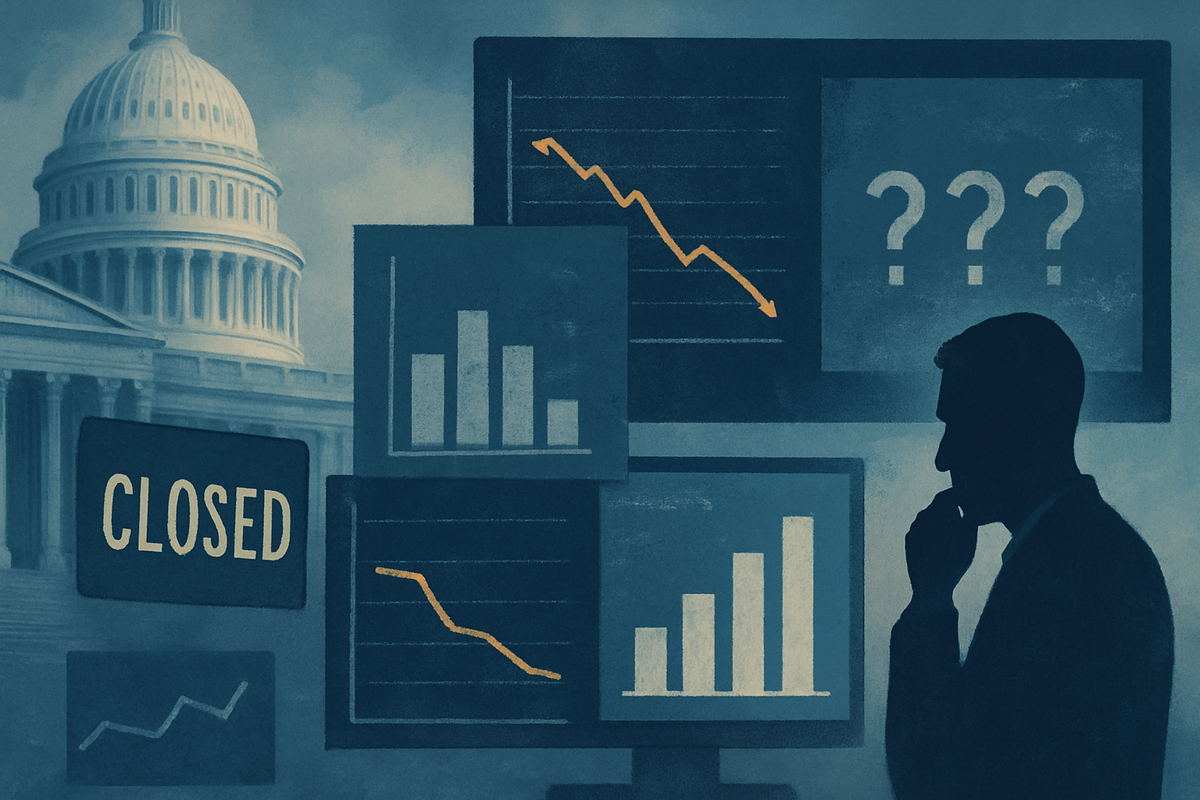
Washington D.C. – October 1, 2025 – A looming U.S. government shutdown, potentially commencing this month, threatens to plunge financial markets and the Federal Reserve into an unprecedented period of uncertainty by halting the release of critical economic data. As Congress grapples with budget impasses, the potential closure of federal agencies responsible for collecting and disseminating vital statistics, most notably the monthly jobs report, could leave policymakers "flying blind" at a crucial juncture for monetary policy.
The immediate casualty of such a shutdown would be the timely flow of economic indicators that serve as the lifeblood of financial analysis and Federal Reserve decision-making. Agencies like the Bureau of Labor Statistics (BLS) and the Bureau of Economic Analysis (BEA) would be forced to suspend "non-essential" operations, leading to delays in key reports on employment, inflation, retail sales, and more. This data vacuum presents a significant challenge for the Federal Reserve, which is highly data-dependent in its assessments of economic health and its subsequent calibration of interest rates, potentially forcing it to make critical policy choices with incomplete information.
Data Blackout: The Shutdown's Immediate Economic Impact
Should the U.S. government cease operations due to a funding lapse this October, the repercussions on economic data dissemination would be swift and severe. The Bureau of Labor Statistics (BLS), the primary agency behind the much-anticipated monthly jobs report (Employment Situation Summary), has contingency plans in place that explicitly state a suspension of all operations, including data collection and report dissemination. This means the September jobs report, typically slated for release on the first Friday of October, would not be issued as scheduled, leaving a gaping hole in the understanding of the nation's labor market health.
Beyond the jobs report, a cascade of other essential economic indicators would face postponement. This includes weekly jobless claims, critical inflation figures such as the Consumer Price Index (CPI) and Producer Price Index (PPI), retail sales data, construction spending, factory orders, housing starts, new home sales, and import prices. The delay of the CPI, usually due in mid-October, would be particularly impactful, given its status as a crucial gauge of inflationary pressures. A prolonged shutdown could also compromise the quality of data collected, as active survey operations would cease, creating a backlog and potential inconsistencies once federal operations resume.
The Federal Reserve (Fed), though an independent agency whose own operations and meetings are not directly affected by a funding lapse, relies heavily on this timely and comprehensive government data. Without access to these "gold-star government data," especially the detailed jobs and inflation reports, the Fed would be operating with significantly limited visibility into the economy's true condition. This "flying blind" scenario exacerbates uncertainty in financial markets and can lead to amplified volatility, as investors and policymakers lack clear signals on the economy's direction. With the Fed's next policy meeting scheduled for October 28-29, 2025, a shutdown extending into the month would mean the central bank would likely lack the September jobs report and the latest inflation data, making its task of setting monetary policy particularly challenging, especially if the economy is presenting conflicting signals.
Market Ripple Effects and Corporate Vulnerabilities
The absence of reliable economic data during a government shutdown creates a significant challenge for businesses and investors, who rely on these indicators to gauge market health, forecast demand, and make strategic decisions. While a direct "winner" from data delays is difficult to pinpoint, certain sectors and companies stand to lose more than others due to the increased uncertainty.
Companies heavily reliant on consumer spending data, such as large retailers like Walmart (NYSE: WMT) and Amazon (NASDAQ: AMZN), or consumer discretionary firms, could find it harder to forecast sales and adjust inventories without timely retail sales figures. Similarly, the housing market, represented by homebuilders like D.R. Horton (NYSE: DHI) and Lennar (NYSE: LEN), as well as mortgage lenders, would suffer from a lack of housing starts and new home sales data, complicating their operational planning and investor confidence. Manufacturing companies, including industrial giants like General Electric (NYSE: GE) and automotive manufacturers like Ford (NYSE: F), would struggle without updates on factory orders and industrial production, making it difficult to assess demand trends.
Financial institutions, including major banks like JPMorgan Chase (NYSE: JPM) and Bank of America (NYSE: BAC), are particularly vulnerable. They depend on a steady stream of economic data to inform their lending decisions, risk assessments, and trading strategies. Increased market volatility stemming from data uncertainty can lead to wider bid-ask spreads, reduced trading volumes, and potential losses. Moreover, the lack of clear signals from the jobs report and inflation data could force the Federal Reserve into a more cautious or unpredictable stance, directly impacting interest rate expectations and, consequently, bank profitability and bond market performance. While some larger, diversified companies might weather the storm better due to their broader access to proprietary data or internal analytics, smaller businesses and those in highly cyclical industries will feel the brunt of the information vacuum, potentially delaying investment decisions and hindering growth.
Broader Implications: A Shadow Over Policy and Precedent
A government shutdown that obscures critical economic data extends its implications far beyond immediate market reactions, casting a long shadow over broader industry trends, regulatory policy, and the very stability of the U.S. economic framework. This event underscores the fundamental role of reliable government statistics in a modern, data-driven economy and highlights the fragility introduced when that flow is interrupted.
In terms of broader industry trends, the phenomenon of "data dependency" among investors, businesses, and policymakers has intensified over the past decades. The Federal Reserve, in particular, has become explicitly data-driven in its monetary policy communications, making the absence of key inputs like the jobs report or CPI particularly disruptive. This situation forces market participants to rely on less comprehensive, often proprietary, private-sector data, which can lead to fragmented interpretations and increased speculation rather than informed decision-making. Such a shift away from universally accepted, transparent government data can erode market efficiency and trust.
The regulatory and policy implications for the Federal Reserve are profound. Without its primary tools for economic assessment, the Fed's ability to confidently signal its future policy path is severely compromised. This could lead to a more conservative "wait-and-see" approach, or, conversely, a more reactive stance if private data suggests significant shifts without official confirmation. Historically, government shutdowns have typically been short-lived, with their economic impacts often temporary and reversible once funding is restored. However, the current environment, marked by persistent inflation concerns and a tight labor market, means that even a brief data blackout could have outsized effects on the Fed's delicate balancing act between controlling inflation and maintaining employment. Past shutdowns, such as those in 2013 and 2018-2019, also saw delays in economic data, forcing the Fed and markets to operate with incomplete pictures, though the context of monetary policy and economic conditions varies. This event fits into a trend of increasing political polarization impacting economic governance, challenging the perceived stability and predictability of U.S. economic policy.
The Path Forward: Navigating an Information Vacuum
The immediate aftermath of a government shutdown in October 2025, particularly one impacting economic data, presents a challenging landscape for both policymakers and market participants. In the short term, the Federal Reserve will likely rely more heavily on its existing economic projections, anecdotal evidence from its regional contacts, and a patchwork of private-sector indicators to inform its October 28-29 meeting. This could lead to a more cautious stance on interest rates, with the Fed potentially opting to maintain its current policy or signal a wait-and-see approach until official data becomes available post-shutdown. Markets, in turn, can expect heightened volatility as investors grapple with increased uncertainty and a lack of clear economic signals, potentially leading to defensive positioning in less cyclical sectors or safe-haven assets.
Looking further ahead, the long-term possibilities hinge on the duration of the shutdown and the subsequent pace of data release. A prolonged data blackout could force businesses to delay investment and hiring decisions, impacting corporate earnings and broader economic growth. Strategic pivots for companies might include increasing reliance on internal analytics teams, subscribing to more alternative data sources, or adopting more conservative financial planning. Market opportunities could emerge for companies that provide alternative economic intelligence or for investors who can accurately interpret a wider array of less conventional indicators. Conversely, challenges will persist for sectors highly sensitive to economic cycles and interest rate changes. Potential scenarios range from a swift resolution with minimal lasting impact to a protracted stalemate that significantly undermines economic confidence and potentially prompts more aggressive, and less informed, Fed interventions.
Conclusion: A Test of Resilience in Uncertain Times
The prospect of a U.S. government shutdown in October 2025 and its ensuing data blackout represents a critical test of resilience for the financial markets and the Federal Reserve's data-driven monetary policy framework. The immediate takeaway is the profound disruption to the flow of essential economic information, transforming a usually transparent landscape into an opaque one. This forces the Fed to operate with incomplete visibility, complicating its ability to make timely and appropriate decisions regarding interest rates and economic stability.
Moving forward, the market will be characterized by increased uncertainty and potential volatility until the government reopens and the backlog of economic data is cleared. Investors should prepare for a period where traditional economic indicators are absent, making fundamental analysis more challenging. Companies may face difficulties in forecasting and strategic planning, particularly those in sectors highly sensitive to consumer spending, housing, or manufacturing. The lasting impact will depend heavily on the duration of the shutdown; a short-lived event might cause temporary turbulence, while a prolonged impasse could erode confidence and introduce significant economic headwinds. Investors should watch closely for any signs of progress in congressional negotiations, the Fed's communications regarding its data reliance, and the performance of alternative economic indicators in the coming months, as these will be crucial guides in navigating this period of informational scarcity.
This content is intended for informational purposes only and is not financial advice






